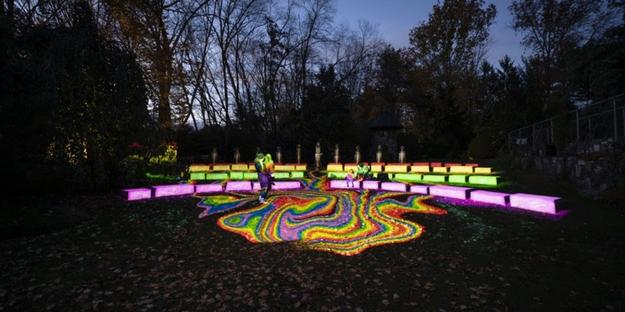Since late November, the Klip Collective, a Philadelphia-based studio that blends lighting, animation, and sound design, has casted lights onto sculptures and natural objects throughout GFS in a technique creative director and founder Ricardo Rivera calls projection mapping.
“Having a big project like this really is a way of activating the winter and we were conscious of wanting to have something that was a unique experience,” says Gary Garrido Schneider, executive director of GFS, which is also a museum and arboretum.
Many outdoor gardens will light up walkways and trees to draw visitors during dark, winter evenings. But GFS, with more than 400 works in its collection, wanted to commission an artist to bring the immersive quality that’s inherent to the park during the daytime into the night.
“That kind of immersiveness, and playfulness and discovery, is really a big part of the kind of approachability of a place like Grounds for Sculpture, which is distinct from other museums,” Schneider says.
In Night Forms: dreamloop by Klip Collective at GPS, the studio’s projection mapping technique uses light and music to transform the grounds, incorporating the natural landscape along the way to create a whole different sense of place.
Rivera says he discovered the video techniques the collective uses somewhat accidentally while aiming a projector at the kitchenette in his then Philadelphia apartment. By plugging his computer into the projector, he realized he could draw on the spaces “down to the pixel.” He recalls projecting vegetables spinning on the cabinets and water on the ceiling.
Klip Collective, which he founded in 2003, has since collaborated with several institutions, including the Hirshhorn Museum in Washington, D.C., and the Philadelphia Museum of Art, and Longwood Gardens, about 30 miles west of Philadelphia.

One of the first pieces that visitors see when they enter Klip Collective’s “dreamloop” exhibition is Arch II, Set II, a sculpture by Elizabeth Strong-Cuevas with a cut-out image in the middle of an undulating 12-foot tall aluminum slab.
To create lighted animations for the sculpture, Rivera and his team used photo scans to make 3-D models of the sculpture. The entire process is technical and time-consuming, “like watching paint dry,” Rivera says. “But when you do it right, it’s awesome.”
A goal is to draw visitors to interact with the sculptures, to walk around them, and see them in new ways. Visitors approaching Arch II, Set II from along the trail will see a pink bug flick across it, and then go around to the back, and Rivera’s hope is that they follow. That’s “because I have two other projectors on the sides that are projecting into the crevices and all the other facets of this very dimensional sculpture,” he says.
Rivera created his own aluminum-based light sculpture for the exhibition titled Sacred Sum, which appears initially as a bunch of animated colorful lines. Visitors who stand in a certain spot—that they have to find on their own—will see the animation align into a cube inside of a triangle that’s inside of a circle.
“I love playing with space and the viewers,” Rivera says.
A musical score created by Klip Collective guides visitors throughout the grounds, and creates a flow to the exhibition, although it can be experienced from any direction. All together, the piece has an “emotional arc,” Schneider says.
“Like a painting or any other work of art, there’s levels of depth,” he says.
At times, Schneider says, the musical score is more upbeat, the images move more quickly, and there’s humor to the animations. “Then it gets a little more esoteric, there are things that look like numerology, and it ends with these pieces that are kind of busy and have a little bit of a glitchy kind of feel, which maybe gives you a sense of like, ‘wait a minute—is all this technology, a good thing?’” he says.
One of the projections is on a sculpture called The Nine Muses, by Carlos Dorrien, which references Greek mythology. The granite pieces of the work appear to be in ruins, although it’s a modern sculpture. At night, the Klip Collective projects a Matrix-like video-game image on the work that adds “so much new depth and other ways of looking at the original sculpture,” Schneider says.
GFS commissioned the Klip Collective to light up the grounds at night for two seasons. The current show was extended through April 3, from 7-11 p.m.









